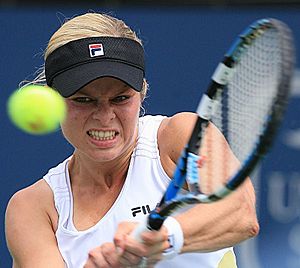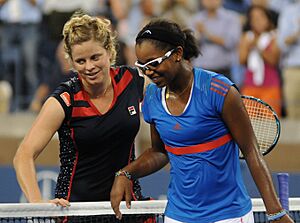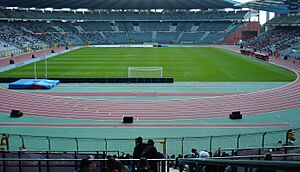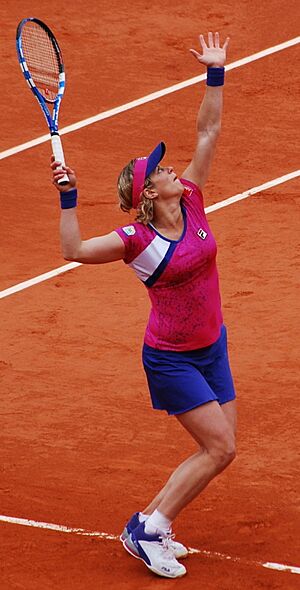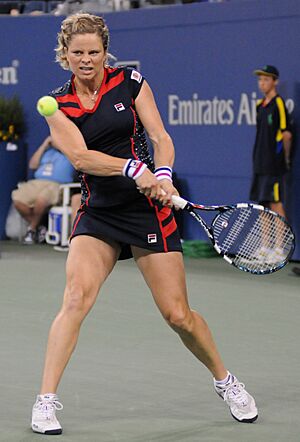Kim Clijsters facts for kids

Clijsters in 2011
|
|
| Country (sports) | |
|---|---|
| Residence | Bree, Belgium New Jersey, U.S. |
| Born | 8 June 1983 Bilzen, Belgium |
| Height | 1.74 m (5 ft 8½ in) |
| Turned pro | 17 August 1997 |
| Retired | 2007–2009; 2012–2020; 12 April 2022 |
| Plays | Right-handed (two-handed backhand) |
| Coach | Fred Hemmes Jr. (2020–2022) |
| Prize money | US$24,545,194
|
| Int. Tennis HoF | 2017 (member page) |
| Official website | kimclijsters.com |
| Singles | |
| Career record | 523–132 (79.85%) |
| Career titles | 41 |
| Highest ranking | No. 1 (11 August 2003) |
| Grand Slam singles results | |
| Australian Open | W (2011) |
| French Open | F (2001, 2003) |
| Wimbledon | SF (2003, 2006) |
| US Open | W (2005, 2009, 2010) |
| Other tournaments | |
| Tour Finals | W (2002, 2003, 2010) |
| Olympic Games | QF (2012) |
| Doubles | |
| Career record | 131–55 (70.43%) |
| Career titles | 11 |
| Highest ranking | No. 1 (4 August 2003) |
| Grand Slam doubles results | |
| Australian Open | QF (2003) |
| French Open | W (2003) |
| Wimbledon | W (2003) |
| US Open | QF (2002) |
| Other doubles tournaments | |
| Tour Finals | F (2003) |
| Mixed doubles | |
| Grand Slam mixed doubles results | |
| French Open | 3R (2000) |
| Wimbledon | F (2000) |
| US Open | 2R (2012) |
| Team competitions | |
| Fed Cup | W (2001) |
| Hopman Cup | RR (2001, 2002, 2003, 2004) |
Kim Clijsters is a famous former professional tennis player from Belgium. She was once ranked the world's number one player in both singles and doubles. Kim won 41 singles titles and 11 doubles titles during her career. This includes four major singles titles, known as Grand Slams, and two major doubles titles.
Kim Clijsters played professionally starting in 1997. She competed against other top players like Justine Henin from Belgium and Serena Williams. Kim and Justine helped make Belgium a strong country in women's tennis. They even led Belgium to win its first Fed Cup in 2001.
After losing her first four major singles finals, Kim finally won her first Grand Slam at the US Open in 2005. She later retired in 2007 at age 23 to get married and have a daughter.
Kim made a surprising return to tennis two years later. She won the US Open in 2009 as an unranked player. She then won the US Open again in 2010 and the Australian Open in 2011. This made her the first mother to be ranked world No. 1. Kim Clijsters retired again after the 2012 US Open. She had a short second comeback from 2020 to 2022.
Kim was known for her amazing athleticism and friendly personality. She could even do splits on the court during matches! She won the Karen Krantzcke Sportsmanship Award eight times. In 2017, she was added to the International Tennis Hall of Fame.
Contents
- Early Life and Family Background
- Junior Tennis Career
- Becoming a Professional Player
- Two-Year Break from Tennis
- Playing for Her Country
- Rivalries
- Exhibition Matches
- Kim Clijsters's Legacy
- How Kim Clijsters Played Tennis
- Coaches Who Helped Kim
- Endorsements and Sponsors
- Kim's Personal Life
- Career Statistics
- Awards and Honors
- See also
Early Life and Family Background
Kim Clijsters was born on June 8, 1983, in Bilzen, Belgium. She grew up in Bree with her younger sister, Elke. Kim's parents were both talented athletes. Her mother, Els, was a Belgian national gymnastics champion. Her father, Lei, was a professional soccer player. He played for the Belgium national soccer team in two World Cups.
Kim says her parents gave her a soccer player's strong legs and a gymnast's flexibility. She also believes their freedom helped her succeed. When Kim was five, her father built a clay tennis court at their home. This was a gift to celebrate his soccer award. Kim had started playing tennis earlier that year with her cousins. She quickly fell in love with the sport.
At age seven, Kim and her sister played at the Tennisdel club in Genk. Her first coach, Bart Van Kerckhoven, remembered Kim's endless energy. She never wanted to leave the court. At nine, she started working with Benny Vanhoudt. She trained for 15 hours a week. Later, Carl Maes became her main coach when she was 13.
Junior Tennis Career
Kim Clijsters was very successful in tennis from a young age. In 1993, at age ten, she won a Belgian junior doubles championship. Her partner was Justine Henin, who would become her rival. A year later, Kim won the singles event at the same tournament. She continued to play with Henin, winning European junior doubles titles in 1996.
Her first big international junior title was at Les Petits As. This is a top tournament for players aged 14 and under. Kim won two junior Grand Slam doubles titles in 1998. She won the French Open with Jelena Dokic and the US Open with Eva Dyrberg. She also reached the singles final at Wimbledon that year. Kim finished 1998 ranked No. 11 in junior singles and No. 4 in junior doubles.
Becoming a Professional Player
1997–1999: Early Success and First WTA Title
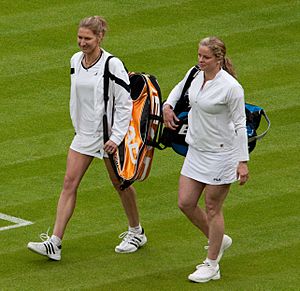
At 14, Kim Clijsters had to play in qualifying rounds to enter professional tournaments. In August 1997, she reached the quarterfinals at her second professional event in Belgium. In July 1998, she won her first professional singles and doubles titles in Brussels. She continued to win more titles on the lower-level ITF Women's Circuit.
In 1999, Kim's ranking was No. 420. Belgian women's tennis was growing stronger. Kim made her main tour debut at the Flanders Women's Open in Belgium. She reached the quarterfinals there.
One week after turning 16, Kim played at Wimbledon. She was the youngest player in the top 200. She reached the fourth round in her first Grand Slam. She beat world No. 10 Amanda Coetzer. Kim then lost to her childhood idol, Steffi Graf. This was their only match. Kim also did well at the US Open, losing to eventual champion Serena Williams in the third round.
Kim won her first WTA title at the Luxembourg Open. This was only her fourth WTA event. She beat the top-ranked Belgian player, Dominique Van Roost, in the final. Kim was named WTA Newcomer of the Year at the end of 1999. Her ranking rose to No. 47.
2000–2002: Reaching Major Finals and Winning the Tour Championship
In 2000, Kim won two more titles: the Tasmanian International and the Sparkassen Cup. The Sparkassen Cup was her first win at a Tier II event, which is a high-level tournament. She also reached the mixed doubles final at Wimbledon with her boyfriend, Lleyton Hewitt.
In 2001, Kim reached her first Tier I final at the Indian Wells Open. She beat world No. 1 Martina Hingis but lost to Serena Williams in the final. A few months later, at the French Open, Kim became the first Belgian to reach a Grand Slam singles final. She beat Justine Henin in the semifinals. The final against Jennifer Capriati was a very close match. Kim lost 12–10 in the final set after more than two hours of play. She won three singles titles in 2001 and finished the year ranked No. 5.
Kim stayed in the top ten in 2002 despite a shoulder injury. She reached the semifinals of the Australian Open. She won three more titles before the year-end WTA Tour Championships in Los Angeles. Only the top 16 players qualify for this event. Kim reached the final easily. She then upset Serena Williams, who had won three Grand Slams that year. Kim called it "the best victory of my career."
2003: World No. 1 in Singles and Doubles
The year 2003 was amazing for Kim Clijsters. She played in 21 singles events and reached the semifinals in almost all of them. She made it to 15 finals and won nine titles. She won 90 matches that year, which was a huge achievement. Kim also played a lot of doubles with Ai Sugiyama, winning seven titles.
This year also saw the peak of her rivalry with Justine Henin. They played each other eight times, with six of those matches being in finals. Kim became the first Belgian player to be ranked world No. 1 in both singles and doubles in August 2003.
Singles: Two Grand Slam Finals
Kim started 2003 by winning the Sydney International. She won 17 matches in a row without losing a set. Her streak ended when she lost to Serena Williams in the Australian Open semifinals. Kim had a big lead in the third set but couldn't close it out.
She then won her first Tier I title at the Indian Wells Open. She won another Tier I title on clay at the Italian Open.
At the French Open, both Kim and Justine Henin reached the final. This meant a Belgian would win a Grand Slam singles title for the first time. Henin won the final easily. After losing in the semifinals at Wimbledon, Kim won two more titles. With these wins, she became the world No. 1 in singles. She was the first woman to reach No. 1 without winning a Grand Slam singles title.
Kim lost to Henin again in the final of the US Open. She then beat Henin in the final of the Tennis Grand Prix to defend her No. 1 ranking. Kim finished her season by winning the WTA Tour Championships again. She earned a million dollars, becoming the first player to earn four million dollars in a season. However, Henin finished the year as the world No. 1.
Doubles: French Open and Wimbledon Titles
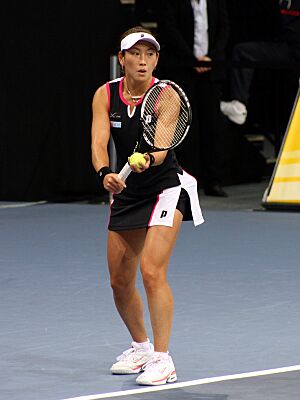
Kim and Ai Sugiyama won three hard court titles early in 2003. They reached the finals of both the French Open and Wimbledon. They beat the top-ranked team of Virginia Ruano Pascual and Paola Suárez in both finals. These were Kim's first two Grand Slam titles. Kim became world No. 1 in doubles in August. She held this ranking for four weeks. After 2003, Kim rarely played doubles.
2004–2005: Injuries and First Grand Slam Singles Title
In 2004, Kim's season was affected by injuries. She injured her left ankle but still reached the final of the Australian Open. She lost to Henin in a close match. In February, Kim won two more tournaments, including her first WTA title in Belgium. She then had to withdraw from tournaments due to a torn wrist tendon. She needed surgery to remove a cyst in her wrist and missed most of the season.
There were low expectations for Kim in 2005 because of her injuries. She missed the Australian Open but returned in February. In March, she won two big tournaments, the Indian Wells Open and the Miami Open. She became the second woman to win both events in the same year, after Steffi Graf. These wins brought her ranking back into the top 20.
After Wimbledon in June, Kim had an amazing run, losing only one match until October. She won five titles, including her first Grand Slam singles title at the US Open. She beat Mary Pierce easily in the final. Kim earned $2.2 million, which was the largest prize money in women's sports at the time. She finished 2005 ranked No. 2, winning nine titles. She was named both WTA Player of the Year and Comeback Player of the Year. Despite this success, Kim announced she planned to retire in 2007 due to her injury problems.
2006–2007: Return to No. 1 and Early Retirement
In 2006, Kim continued to struggle with injuries. She played only 14 tournaments and missed the US Open. She reached the semifinals at the other three Grand Slams. She regained the No. 1 ranking in January 2006. Henin beat Kim in the semifinals of three straight events, including the French Open and Wimbledon. Kim won another title in Belgium before losing in the semifinals of the WTA Tour Championships.
Kim planned to retire at the end of 2007, but injuries limited her to only five tournaments. She won her only title of the year at the Sydney International. She reached the semifinals of the Australian Open. A hip injury affected her remaining schedule. Kim announced her retirement at age 23 in May 2007.
Two-Year Break from Tennis
A few months after retiring, Kim married American basketball player Brian Lynch. Their daughter was born in early 2008. Kim's father passed away in January 2009. Kim said her daughter's birth was the best moment of her life, but it was also sad knowing her father was ill.
In March 2009, Kim announced she was planning to return to tennis. She was motivated by an exhibition match at Wimbledon to test the new roof. She said she was taking a different approach, seeing it as a "second career." Kim won the exhibition doubles match and beat Steffi Graf in singles. She felt her motivation for tennis had returned.
2009–2010: Second Career and US Open Titles
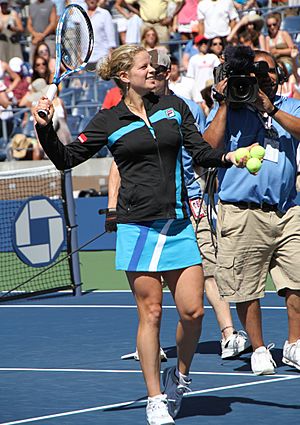
Kim needed special invitations, called wild cards, to play in tournaments since she had no ranking. She received wild cards for the Cincinnati Open, the Canadian Open, and the US Open. In Cincinnati, she beat three top 20 players.
At the US Open, Kim was still unranked. She made it to the final, beating both Williams sisters. She upset No. 3 Venus in the fourth round and No. 2 Serena in the semifinals. Kim then defeated No. 8 Caroline Wozniacki to win her second US Open title. She became the first unseeded woman to win the event and the first mother to win a Grand Slam singles title since 1980. She finished the year ranked No. 19 and won the WTA Comeback Player of the Year award again.
In 2010, Kim played a limited schedule to focus on her family. She won the Brisbane International, beating Henin in a close match. She won the Miami Open for the second time. Kim missed the French Open due to a foot injury. She reached the quarterfinals at Wimbledon.
Kim defended her title at the US Open. She beat three top ten players in the last three rounds. She won the final easily against Vera Zvonareva. This was her third straight US Open title. Kim also won her third title at the WTA Tour Championships. She finished 2010 ranked No. 3 and was named WTA Player of the Year for the second time.
2011–2012: Australian Open Champion and Final Retirement
By 2011, Kim planned to retire in 2012. She started the season by reaching the final of the Sydney International. She then met Li Na again in the final of the Australian Open. Kim won the championship, her fourth Grand Slam singles title and first outside the US Open. This was her last career title.
She briefly regained the world No. 1 ranking in February 2011. However, injuries limited her play for the rest of the year. She missed Wimbledon due to an ankle injury. An abdominal injury kept her out for the rest of 2011.
In her last year on tour, 2012, Kim struggled to stay healthy. She reached the semifinals of the Australian Open. She beat No. 5 Li Na and world No. 1 Caroline Wozniacki. However, she lost to Victoria Azarenka in three sets. Her hip and ankle injuries continued to bother her.
Kim played her last WTA singles match win against Victoria Duval at the US Open. She then lost to Laura Robson in her next match. Her career officially ended with a mixed doubles loss.
2020–2022: Second Comeback
After more than seven years, Kim Clijsters returned to professional tennis in February 2020. She played in the Dubai Tennis Championships as a wildcard. She lost her first match to Garbiñe Muguruza. She also played in the Monterrey Open and the US Open, losing in the first round of both.
Kim had knee surgery in October 2020. She pulled out of the 2021 Miami Open in 2021, saying she wasn't ready after surgery and getting COVID-19. She played a few more tournaments in 2021 but didn't win any matches.
On April 12, 2022, Kim announced she was ending her second comeback. She wanted to focus more on her family life.
Playing for Her Country
Fed Cup
Kim Clijsters first played for Belgium in the Fed Cup in 2000 at age 16. In 2001, Kim, Justine Henin, and their teammates won Belgium's first Fed Cup title. They beat Russia in the final.
In 2006, Belgium almost won the Fed Cup again. Kim and Henin helped the team reach the final. However, Kim missed the final due to a wrist injury. Belgium lost to Italy in a very close match. Overall, Kim had a great record in Fed Cup, winning 24 out of 28 matches.
Olympics
Kim Clijsters didn't play in the Olympics until 2012. She had chances to play in 2000 and 2004 but didn't. In 2004, she couldn't play because of a contract with her clothing sponsor. The 2008 Olympics happened during her first retirement.
Kim really wanted to represent Belgium at the 2012 London Games. In her Olympic debut, she won her first three matches. She reached the quarterfinals but lost to No. 3 Maria Sharapova.
Rivalries
Kim Clijsters vs. Justine Henin
Kim Clijsters's biggest rival was Justine Henin. They started as friends and even won junior doubles titles together. But their friendship faded as they became rivals. Kim said one of Henin's coaches told her to "hate all of her opponents."
They played each other 25 times on the WTA Tour. Kim won 13 matches, and Henin won 12. Henin won seven of their eleven finals, including all three at Grand Slams. Kim won all three of their matches after they both returned from retirement.
Kim Clijsters vs. Williams Sisters
The Williams sisters, Serena and Venus, were also top players during Kim's career. Kim had a tough record against Serena, winning only 2 out of 9 matches. Serena won all their three-set matches. However, Kim's two wins against Serena were very important. She beat Serena to win the 2002 WTA Tour Championship and again at the 2009 US Open.
Kim had a winning record against Venus, 7 wins to 6 losses. Venus won six of their first eight matches. But Kim won their last five meetings. Three of those wins came at the US Open, helping Kim win her three titles there.
Other Rivals
Kim also had rivalries with other former world No. 1 players like Lindsay Davenport and Amélie Mauresmo. Kim had slightly winning records against both. She beat Davenport in all four of their finals. Kim won eight of her first ten matches against Mauresmo, but Mauresmo won their last five.
Exhibition Matches
In 2009, Kim played an exhibition match at Wimbledon. This match inspired her to return to the WTA Tour. She also played in the World Team Tennis league to prepare for her comeback.
On July 8, 2010, Kim played an exhibition match against Serena Williams in Belgium. They wanted to set a new world record for attendance at a tennis match. A total of 35,681 people watched, breaking the old record.
Kim also played in exhibition matches at the Diamond Games in Belgium. She played against Venus Williams, Henin, and Caroline Wozniacki. After her retirement, she became the tournament director for the Diamond Games in 2015.
Since retiring in 2012, Kim has played in "legends" or "invitation" doubles events at Grand Slams. In 2017, she famously invited a male spectator onto the court at Wimbledon to play a few points.
Kim Clijsters's Legacy
Kim Clijsters is considered one of the greatest women's tennis players. Her 41 singles titles are among the most in the Open Era. Only a few players have won more Grand Slam singles titles than her four since 2000. She won titles at all four Grand Slam tournaments (singles at US Open and Australian Open, doubles at French Open and Wimbledon). She is one of only six players to be ranked No. 1 in both singles and doubles at the same time.
Kim and Justine Henin are credited with "putting Belgium on the tennis map." Before them, Belgium had few top-ranked tennis players. With Kim on the team, Belgium reached the Fed Cup semifinals four times and won the championship in 2001.
After her retirement, Kim started the Kim Clijsters Academy to help young tennis players.
Kim was one of the most popular and well-liked players. She won the Karen Krantzcke Sportsmanship Award a record eight times. She was proud to be known as a kind person. Kim also inspired mothers on the WTA Tour. She is one of only three mothers to win a Grand Slam singles title. Her three titles as a mother are tied for the most ever. She is also the only mother to be ranked No. 1 in the world since 1975. In 2011, she was on the Time 100 list because of her successful comeback.
How Kim Clijsters Played Tennis
Kim Clijsters was an "all-court" player. This means she used both offensive and defensive styles. She was known for her amazing movement, which helped her last through long rallies. Other players said she could get "every ball back."
Kim's special shot was a stretched-out wide forehand, sometimes called a squash shot. She could hit this shot while sliding on any surface, which is very rare. She often finished these shots in a split.
Kim was strong at hitting winners from the baseline with both her forehand and backhand. She was also one of the best at returning serves. She tried to take control of the point right away. Kim was also good at moving from the back of the court to the net to finish points. Her experience in doubles helped her improve her net game in singles. Her coach said she became more aggressive after her first retirement.
Coaches Who Helped Kim
Kim Clijsters worked with Belgian coaches throughout her career. Her first coach was Bart Van Kerckhoven. She started her professional career with Carl Maes as her coach. Maes coached her from 1996 to 2002. During this time, she won the Fed Cup and reached the French Open final.
In 2002, she hired Marc De Hous. With him, Kim won two WTA Tour Championships and two Grand Slam doubles titles. They stopped working together after she won her first Grand Slam singles title in 2005. Kim then played without a coach until her first retirement.
When Kim returned in 2009, she hired Wim Fissette. He had been her hitting partner before. With Fissette, Kim won three more Grand Slam singles titles and became world No. 1 again. In 2011, she rehired Carl Maes, and Fissette left. Kim worked with Maes until her second retirement. In 2020, for her second comeback, she announced Fred Hemmes Jr. as her new coach.
Endorsements and Sponsors
Kim Clijsters was represented by Golazo Sports. Babolat has sponsored her tennis racquets since 1999. Fila has been her clothing sponsor since 2002.
Kim was careful about which products she supported. She said she wouldn't endorse products that weren't healthy for kids. She had deals with companies like Chiquita (bananas), United Soft Drinks (sports drinks), USANA (nutrition), Citizen Watch, Telenet (telecommunications), Adecco (personnel services), and Thomas Cook Group (travel).
Since her retirement, Van Lanschot banking helps sponsor the Kim Clijsters Academy.
Kim's Personal Life
Kim Clijsters is married to Brian Lynch, an American basketball coach. They met because they both had pet bulldogs. They married in 2007. They have three children: a daughter, Jada (born 2008), and two sons, Jack (born 2013) and Blake (born 2016). The family lives in both Bree, Belgium, and New Jersey, USA.
Kim's younger sister, Elke, was also a talented tennis player. Elke won two junior Grand Slam doubles titles. She retired in 2004 at age 19 due to back problems.
Early in her career, Kim was in a relationship with Australian tennis player Lleyton Hewitt. They were engaged but broke up in 2004. Their relationship earned Kim the nickname "Aussie Kim." When she won the 2011 Australian Open, she felt she truly earned that nickname.
Kim's childhood tennis idol was Steffi Graf. She said playing against Graf at Wimbledon in 1999 was a huge moment. It motivated her greatly. She also looked up to Monica Seles.
Kim helps children through different organizations. She has been an ambassador for SOS Children's Villages since 2010. She also founded Ten4Kim, a nonprofit that helps young tennis players who can't afford high-level training.
After retiring, Kim sometimes worked as a part-time coach for other players. She also occasionally commented on tennis matches for TV.
Career Statistics
Grand Slam Performance in Singles
| Tournament | 1999 | 2000 | 2001 | 2002 | 2003 | 2004 | 2005 | 2006 | 2007 | 2008 | 2009 | 2010 | 2011 | 2012 | 2020 | 2021 | Wins / Played | Win–Loss |
|---|---|---|---|---|---|---|---|---|---|---|---|---|---|---|---|---|---|---|
| Australian Open | A | 1R | 4R | SF | SF | F | A | SF | SF | A | A | 3R | W | SF | A | A | 1 / 10 | 43–9 |
| French Open | A | 1R | F | 3R | F | A | 4R | SF | A | A | A | A | 2R | A | A | A | 0 / 7 | 23–7 |
| Wimbledon | 4R | 2R | QF | 2R | SF | A | 4R | SF | A | A | A | QF | A | 4R | NH | A | 0 / 9 | 28–9 |
| US Open | 3R | 2R | QF | 4R | F | A | W | A | A | A | W | W | A | 2R | 1R | A | 3 / 10 | 38–7 |
| Total Win–Loss | 5–2 | 2–4 | 17–4 | 11–4 | 22–4 | 6–1 | 13–2 | 14–3 | 5–1 | 0–0 | 7–0 | 13–2 | 8–1 | 9–3 | 0–1 | 0–0 | 4 / 36 | 132–32 |
Grand Slam Performance in Doubles
| Tournament | 2000 | 2001 | 2002 | 2003 | 2004–2011 | 2012 | Wins / Played | Win–Loss |
|---|---|---|---|---|---|---|---|---|
| Australian Open | 1R | 3R | 3R | QF | A | A | 0 / 4 | 7–4 |
| French Open | 1R | 3R | A | W | A | A | 1 / 3 | 8–2 |
| Wimbledon | 2R | F | A | W | A | A | 1 / 3 | 12–2 |
| US Open | 3R | A | QF | 2R | A | 1R | 0 / 4 | 6–4 |
| Total Win–Loss | 3–4 | 9–3 | 5–2 | 16–2 | 0–0 | 0–1 | 2 / 14 | 33–12 |
Grand Slam Finals: Singles (4 Titles, 4 Runner-ups)
| Result | Year | Championship | Surface | Opponent | Score |
|---|---|---|---|---|---|
| Loss | 2001 | French Open | Clay | 6–1, 4–6, 10–12 | |
| Loss | 2003 | French Open | Clay | 0–6, 4–6 | |
| Loss | 2003 | US Open | Hard | 5–7, 1–6 | |
| Loss | 2004 | Australian Open | Hard | 3–6, 6–4, 3–6 | |
| Win | 2005 | US Open | Hard | 6–3, 6–1 | |
| Win | 2009 | US Open | Hard | 7–5, 6–3 | |
| Win | 2010 | US Open | Hard | 6–2, 6–1 | |
| Win | 2011 | Australian Open | Hard | 3–6, 6–3, 6–3 |
Grand Slam Finals: Doubles (2 Titles, 1 Runner-up)
| Result | Year | Championship | Surface | Partner | Opponents | Score |
|---|---|---|---|---|---|---|
| Loss | 2001 | Wimbledon | Grass | 4–6, 3–6 | ||
| Win | 2003 | French Open | Clay | 6–7(5–7), 6–2, 9–7 | ||
| Win | 2003 | Wimbledon | Grass | 6–4, 6–4 |
Grand Slam Finals: Mixed Doubles (1 Runner-up)
| Result | Year | Tournament | Surface | Partner | Opponents | Score |
|---|---|---|---|---|---|---|
| Loss | 2000 | Wimbledon | Grass | 4–6, 6–7(3–7) |
Awards and Honors
Kim Clijsters received many awards throughout her career:
International Tennis Federation (ITF) Awards
- World Champion: 2005
Women's Tennis Association (WTA) Awards
- Newcomer of the Year: 1999
- Karen Krantzcke Sportsmanship Award: 2000, 2001, 2002, 2003, 2005, 2006, 2009, 2012 (a record eight times!)
- Peachy Kellmeyer Player Service Award: 2003, 2006, 2010
- Comeback Player of the Year: 2005, 2009
- Player of the Year: 2005, 2010
- Humanitarian of the Year: 2006
National Belgian Awards
- Belgian Promising Youngster of the Year: 1998
- Belgian Sportswoman of the Year: 1999, 2000, 2001, 2002, 2005, 2009, 2010, 2011
- Vlaamse Reus: 2000, 2001, 2010
- Flemish Sportsjewel: 2001
- Belgian National Sports Merit Award: 2001 (with Justine Henin)
- Belgian Sports Personality of the Year: 2003
- Grand Cross of the Order of the Crown: 2003 (with Justine Henin)
- Belgian Sporting Team of the Year: 2006 (with the Fed Cup team)
International Awards
- Laureus World Sports Award for Comeback of the Year: 2010
- International Tennis Hall of Fame inductee: 2017
See also
 In Spanish: Kim Clijsters para niños
In Spanish: Kim Clijsters para niños


